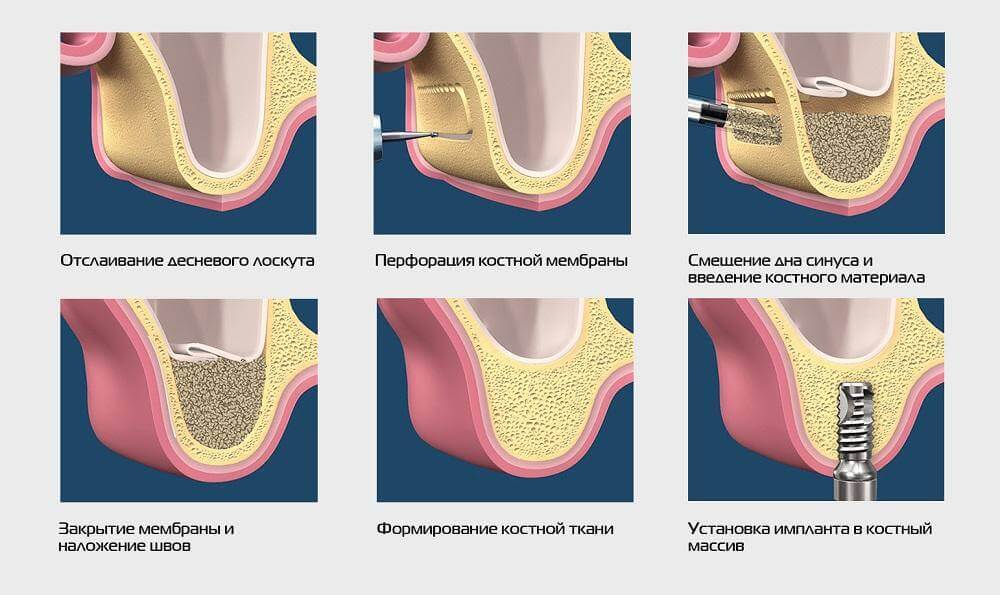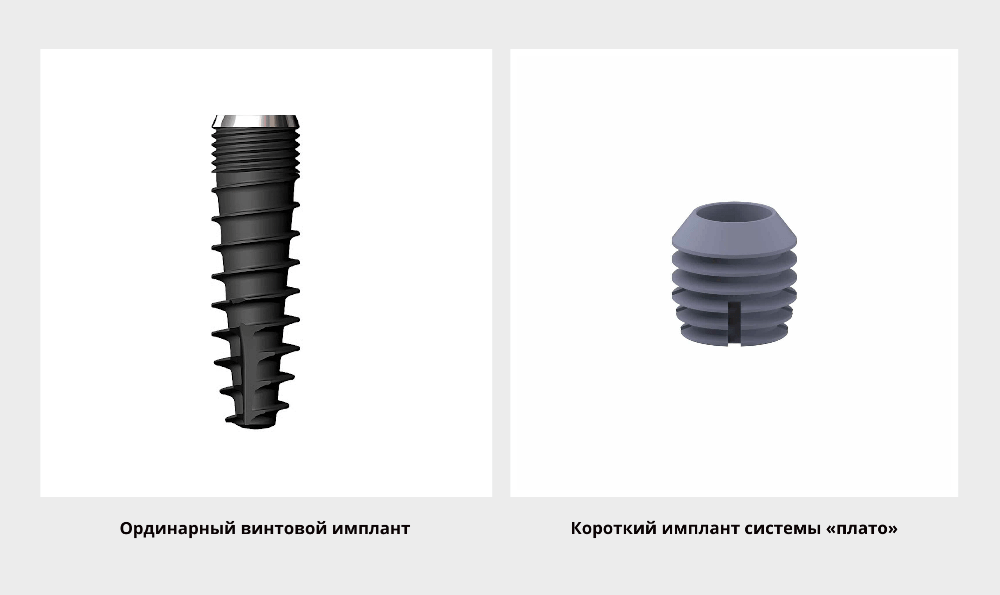A sinus lift is an upper jaw surgery aimed at increasing the bone volume when it is not high enough for placing an ordinary screw-type implant with a length of 8 to 12 mm. The essence of the surgery is to elevate the maxillary sinus mucosa, followed by the placement of osteoplastic material.
Osteoplastic material can be:
- Allogeneic Screw and “short” implants taken from a human donor
- Xenogenic — taken from an animal donor (cow, pig)
- Synthetic — chemical (calcium phosphate)
- Autogenous Screw and “short” implants taken from the patient during surgery.
All officially registered bone materials are cleaned, tested for diseases, such as hepatitis, HIV, and others, and subsequently sterilized in individual containers using gamma rays.
Why Does Bone Loss Happen?
Anatomically, the tooth root is located in the alveolar process of the jaw. The bone deteriorates and changes its structure due to dental diseases: periodontitis (periodontal disease) and others. After tooth extraction, the bone changes both in volume and height. The bone eventually becomes thinner in the area with no teeth. Since there is no load on the bone, the blood supply decreases, and the bone diminishes in volume. For this reason, it makes sense to place dental implants immediately after a tooth extraction or as soon as possible.
Often, there are difficulties with the placement of implants in the lateral areas of the upper jaw, where the teeth roots are physiologically connected to the maxillary sinus cavity, because the bone tissue lacks the necessary volume (height). If an implant of standard length is installed in such a bone without any bone grafts, part of the implant may penetrate the maxillary sinus cavity located above. This phenomenon is extremely unpleasant and dangerous and can lead to chronic inflammation — maxillary sinusitis (a common complication observed after dental implants on the upper jaw).
To prevent this, the internal lining of the maxillary sinus cavity must be separated from the bone and filled with a bone substitute. This is the very essence and point of sinus lift surgery. That is, we lift the mucosa of the maxillary sinus cavity, put bone material, which will eventually (usually, in 3-6 months) become a stable bone modulating structure, and then install a dental implant.
What Is the Difference Between Open and Closed Sinus Lift Surgery?
The difference lies in the technique used by the surgeon to perform bone-plastic surgery. If we are talking about a closed sinus lift, we lift the mucosa of the maxillary sinus cavity through the hole we make for the future implant. Gently, using a tool (there are many of them), we lift the mucosa and insert the bone material there without opening the outer lateral wall of the sinus.

Open sinus lift surgery is when we open the lateral wall of the upper jaw bone, make a “window” in the maxillary sinus above the tooth roots, gently move the mucosa away from the inner wall of the bone, and put the bone material there. Then, this place is closed with a membrane, sutured, and healed. Only upon healing, we can place a dental implant without damaging the integrity of the maxillary sinus cavity.

Negative Effects of Sinus Lift Surgery
During sinus lift surgery, we artificially increase the volume of the alveolar bone, but we decrease the anatomical volume of the maxillary sinus cavity, which is the nasal cavity and is very important for nasal breathing. Besides, such an intervention can lead to other complications, which we will discuss in a separate section. But several important points go beyond the teeth issue.
First. Suppose a patient has cardioneurosis (heart disease). Where to go and what to do? There is a very simple method: 15 deep inhalations through the nose and exhalations through the mouth, and the cardioneurosis noticeably decreases, making the person feel better. In other words, if nature has created us with a certain volume of maxillary cavities, through which the physiological volume of air circulates, we should not reduce it by any manipulations.
Second. There is a scientific opinion that a decrease in the volume of the maxillary cavities leads to bronchial asthma. Yes, we can install a tooth with the help of sinus lift surgery, but in turn, you have to be prepared for the risk of developing bronchial asthma.
Third. The bone material used during sinus lift surgery will never become your native bone, just like in the case of hair or nail extensions. The effectiveness of sinus lift surgery is not predictable enough. People are different, and each body reacts differently to foreign materials. Someone’s body will “eat” all the bone material used to augment the bone (it will simply be resorbed). A sinus lift isn’t effective in all cases, and it is not for everyone.
Fourth. Autoimmune reaction. We inject either non-native protein (if it is organic bone) or non-native material (if it is calcium phosphate) into the person’s body. As stated above, there are several types of bone materials used. They are allogeneic human bone material (bone material is taken from a donor bank), xenogenic bone material (bulls or pigs from which biological bone material is taken), and synthetic bone material (calcium phosphate). And a person can develop an autoimmune reaction, which is a severe disease, to all these materials.
The most suitable material for bone plastic surgeries, including a sinus lift, is a patient’s bone. But if we take a piece of bone from the human body in one place and transplant it to another place, the body can still perceive this as a problem and simply “destroy” it.
Why Is Sinus Lift Surgery Not Desirable?
First. Sometimes, sinus lift surgery can be pointless because we don’t get the extra amount of bone that we intended to get. And this happens quite often.
Second. We break the integrity of the maxillary sinus. We’re interfering in a non-dental area.
Third. By performing sinus lift surgery for the subsequent placement of screw-type implants, we essentially agree to two surgeries: the first is “bone augmentation,” and the second is the placement of a dental implant.
What Is the Alternative to Sinus Lift Surgery?
Is there an option to place a dental implant without a sinus lift? In most cases, we can offer an alternative to sinus lift surgery – short plateau-type dental implants that can be placed in thin bone without the need for sinus lift surgery. Unlike regular screw-type implants, short plateau-type implants do not cause any problems thanks to their configuration and surface.

The advantages of short implants are that the placement result is more predictable and the recovery time is shorter (complete healing of the bone around the implant takes about 2 months).
You should also know that there are no medical indications for sinus lift surgery.


